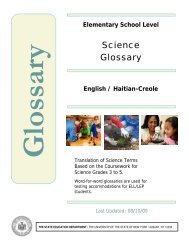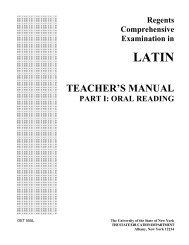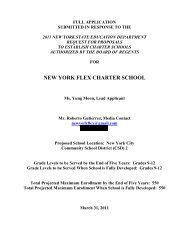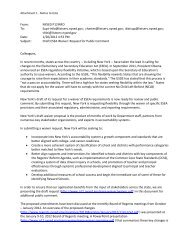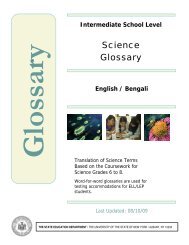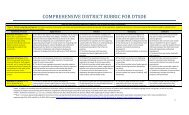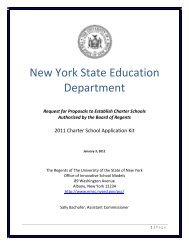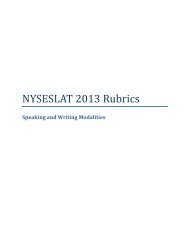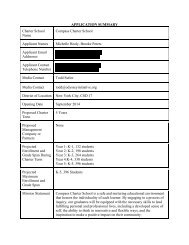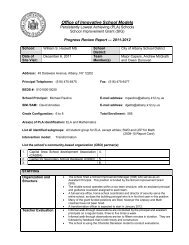New Visions Charter High School for Humanities III - p-12
New Visions Charter High School for Humanities III - p-12
New Visions Charter High School for Humanities III - p-12
You also want an ePaper? Increase the reach of your titles
YUMPU automatically turns print PDFs into web optimized ePapers that Google loves.
I. EXECUTIVE SUMMARY: THE NEW VISIONS CHARTER HIGH SCHOOL FOR THE<br />
HUMANITIES <strong>III</strong> (HUM CHARTER <strong>III</strong>) i<br />
<br />
The <strong>New</strong> <strong>Visions</strong> <strong>Charter</strong> <strong>High</strong> <strong>School</strong> <strong>for</strong> the <strong>Humanities</strong> <strong>III</strong> (HUM <strong>Charter</strong> <strong>III</strong>) provides all<br />
students, regardless of their previous academic history, the highest quality education in an<br />
atmosphere of respect, responsibility and rigor.<br />
HUM CHARTER <strong>III</strong> ensures that its graduates have the skills and content knowledge necessary to<br />
succeed in their post-secondary choices by engaging its students, teachers and administrators in<br />
coherent learning experiences that allow risk-taking, embrace multiple attempts at learning,<br />
cultivate students’ imaginative and creative abilities, and celebrate achievement. Through an<br />
intensive study of the humanities – the stories, the ideas, and the words that help us make sense of<br />
our lives – students generate research questions, develop the skills necessary to answer those<br />
questions, imagine and create products that demonstrate their understanding, and defend their<br />
knowledge publicly.
For over a decade, <strong>New</strong> <strong>Visions</strong> <strong>for</strong> Public <strong>School</strong>s has been a leader in developing, implementing and<br />
managing strategies <strong>for</strong> turning around chronically low per<strong>for</strong>ming schools. Our flagship enterprise, the<br />
<strong>New</strong> Century <strong>High</strong> <strong>School</strong> Initiative, remains unprecedented in the country in its intensity, scale,<br />
innovation, widespread engagement of multiple stakeholders and, most importantly, its impact on high<br />
school students.<br />
The NCHS Initiative resulted in schools that serve higher percentages of students who receive free or<br />
reduced lunch, are African American and/or Latino and/or who enter 9 th grade at levels 1 or 2 on the <strong>New</strong><br />
York State ELA and Math assessments than the citywide average. And, NCHSI resulted in schools that<br />
outper<strong>for</strong>med the citywide average on key indicators of student per<strong>for</strong>mance.<br />
Studies by Policy Studies Associates, demonstrate that <strong>New</strong> Century’s key strategies—the use of clear,<br />
research-based design principles to guide school creation and implementation; partnerships with lead<br />
civic groups, social service agencies and content experts; and the use of teacher-driven inquiry and data<br />
management strategies—have resulted in schools with substantially higher attendance, credit<br />
accumulation, and graduation rates, particularly <strong>for</strong> low income students, students with disabilities and<br />
English Language Learners. (PSA 2006, 2006, 2008)<br />
Building upon this rich history, <strong>New</strong> <strong>Visions</strong> proposes HUM CHARTER <strong>III</strong> as the 6 th charter high school<br />
in an evolving network of 18 high-per<strong>for</strong>ming public charter high schools in high-need neighborhoods.<br />
HUM CHARTER <strong>III</strong> is designed to meet the needs of high school aged students from across the Bronx,<br />
our target audience. Drawing upon the most promising practices from our NYC district public schools,<br />
we have defined a specific <strong>New</strong> <strong>Visions</strong> charter high school model that will drive students to success in<br />
college and careers through radically different learning opportunities and school services. The model<br />
spans grades 9-<strong>12</strong> and includes support <strong>for</strong> students during their first year of post-secondary experience.<br />
Included in this ef<strong>for</strong>t is our strategy to pioneer technology-infused curricula and assessments through an<br />
instructional system that maximizes student exposure to leading-edge materials and learning. We seek to<br />
share the practices and learning from this work to our district schools (and vice versa), as well as deliver<br />
on the original promise of charter schooling as an innovation lab that impacts the larger school system<br />
and the field as a whole.<br />
HUM CHARTER <strong>III</strong>’s key design elements include:<br />
1. Writing to Think: We found that in the schools that are available to our target students, writing is<br />
not approached systematically. On the rare occasions when students are asked to write, there are no<br />
systems in place to give them coherent feedback.<br />
In our approach writing is taught systematically: all teachers are required to use writing in their<br />
classes; writing assignments are arranged in coordinated, two-week cycles; a common rubric is used<br />
with feedback going to students and the students’ team of teachers prior to the beginning of the next<br />
cycle; and, a technological plat<strong>for</strong>m such as Google Docs allows students to ef<strong>for</strong>tlessly collect their<br />
work and teachers can easily access multiple drafts of student writing <strong>for</strong> assessment purposes.<br />
2. Accelerating to Achieve: We found that in the schools that are available to our target students there<br />
are few structures in place to address the fact that students enter per<strong>for</strong>ming below grade level.<br />
In our approach, the school will be divided into a Lower House and an Upper house.<br />
a. The 8-9 Bridge, 9 th grade, 9-10 Bridge, 10 th grade allow students to get up to speed and to<br />
meet minimum testing requirements <strong>for</strong> graduation while working towards the ultimate goal<br />
of college and career level proficiency.<br />
b. Students move into Upper House when they meet 10 th grade exit criteria and demonstrate a<br />
capacity to work independently.<br />
A trimester structure allows students to engage in a series of focused, 13 week, standards aligned<br />
courses that result in the accumulation of between 15 and 18 credits per year. This system creates the<br />
T h e N e w V i s i o n s C h a r t e r H i g h S c h o o l f o r t h e H u m a n i t i e s<br />
I I I ( H U M C h a r t e r I I I )<br />
Page 2 of 18
time and space in the upper house <strong>for</strong> students to participate in internships and apprenticeships as well<br />
as take classes on college campuses while still having the support of the high school faculty.<br />
3. Assessing to Grow: We found that in the schools that are available to our target students, assessment<br />
is used to classify students rather than to guide growth and learning, that assessment in<strong>for</strong>mation is<br />
not broadly and readily accessible and that grading policies do not give students and families<br />
in<strong>for</strong>mation about what they have learned.<br />
In our approach diagnostic and <strong>for</strong>mative assessments are used by teachers to understand what their<br />
students have mastered as well as the content and skills with which they still need to master;<br />
in<strong>for</strong>mation from the assessments guides the lesson construction and sequencing and the grading<br />
policy will be aligned to Common Core State Standards so that students and families can clearly see<br />
where they are in the quest to graduate. We will also use a technology plat<strong>for</strong>m which allows<br />
assessment in<strong>for</strong>mation to be broadly accessible to students, families and teams of teachers.<br />
4. Questioning to Learn: We found that in the schools that are available to our target students, students<br />
are bored. The practiced curriculum is irrelevant and classes are disconnected…Students constantly<br />
are asking, “Why do I need to learn this?” Teachers do not have mechanisms to know how students<br />
are doing across classes inadvertently promoting incoherent planning.<br />
In our approach teachers design and students engage in Challenge Curricula and Anchor Projects that<br />
address questions relevant to students and their communities. The unit questions provide rationale <strong>for</strong><br />
engaging in the study and create a need to know. For example, a unit designed <strong>for</strong> the Math and<br />
English classes explores ways in which the students can develop a sustainable source of revenue in<br />
order <strong>for</strong> them to develop and participate in 9 th grade community building activities. The unit<br />
requires students to develop a business plan that can be implemented by the class and that will meet<br />
the established fundraising goal. This type of unit requires students to develop skills associated with,<br />
needs assessment, market research, proposal development, marketing and fundraising. Additionally,<br />
teachers have time every day to focus on the learning that is occurring in their classrooms through a<br />
<strong>for</strong>mal inquiry process where they collaboratively determine strategies to use with students who are<br />
struggling.<br />
5. Teaming to Succeed: We found that in the schools that are available to our target students, they and<br />
their teachers experience school as a set of isolated experiences.<br />
In our approach students work both individually and in groups to address the curricular challenges.<br />
Teachers have time built into their schedules to participate on the Cohort Inquiry Teams and are<br />
supported by the administrative team – a Cohort Assistant Principal and a Guidance Counselor – to<br />
meet, reflect on their practice and plan on a daily basis. <strong>School</strong> Leadership Teams are supported by<br />
<strong>Charter</strong> Director of Instruction to reflect on the emerging knowledge of the Cohort Inquiry Teams.<br />
Principals have time to participate on the Network Inquiry Team and are supported in studying the<br />
per<strong>for</strong>mance of their schools and their colleagues’ schools, reflect on practice, and determine<br />
emerging needs of the network. <strong>School</strong>s are teamed with Lincoln Center Institute to develop and<br />
implement the challenge-based curriculum.<br />
6. Practicing to Excel: We found that in the schools that are available to our target students, they do<br />
not identify and utilize practices that lead to excellence.<br />
In our approach students get the opportunity to practice and excel at developing questions <strong>for</strong><br />
research, engaging in research across a variety of media, producing artifacts that show evidence of<br />
their learning and defending their knowledge to their peers, their teachers and outside audiences.<br />
Students get an opportunity to excel at writing through the broad use of the agreed upon pedagogical<br />
approach over 4 years. We are exploring additional options <strong>for</strong> students to select and participate in a<br />
long-term engagement in debate, strategic games, art, music, and per<strong>for</strong>mance in order to promote<br />
persistence and excellence.<br />
T h e N e w V i s i o n s C h a r t e r H i g h S c h o o l f o r t h e H u m a n i t i e s<br />
I I I ( H U M C h a r t e r I I I )<br />
Page 3 of 18
II. STUDENT POPULATION: THE NEW VISIONS CHARTER HIGH SCHOOL FOR THE<br />
HUMANITIES <strong>III</strong> (HUM CHARTER <strong>III</strong>)<br />
A. Student Enrollment: Anticipated Enrollment Table<br />
Number of Students<br />
Grades Ages 20<strong>12</strong>-2013 2013-2014 2014-2015 2015-2016 2016-2017<br />
K NA 0 0 0 0 0<br />
1 NA 0 0 0 0 0<br />
2 NA 0 0 0 0 0<br />
3 NA 0 0 0 0 0<br />
4 NA 0 0 0 0 0<br />
5 NA 0 0 0 0 0<br />
6 NA 0 0 0 0 0<br />
7 NA 0 0 0 0 0<br />
8 NA 0 0 0 0 0<br />
9 13-15 <strong>12</strong>5 <strong>12</strong>4 150 150 150<br />
10 14-16 0 <strong>12</strong>5 <strong>12</strong>5 150 150<br />
11 15-18 0 0 <strong>12</strong>2 <strong>12</strong>2 146<br />
<strong>12</strong> 16-19 0 0 0 <strong>12</strong>0 <strong>12</strong>0<br />
Total # of<br />
students<br />
Number of<br />
classes per<br />
grade<br />
Average<br />
number of<br />
students per<br />
class<br />
per class<br />
<strong>12</strong>5 249 397 542 566<br />
5 classes<br />
/9 th grade<br />
5<br />
classes total<br />
5 classes<br />
/9 th & 10 th<br />
grade<br />
10<br />
classes total<br />
6 classes<br />
/9 th grade<br />
5 classes<br />
/10&11 th<br />
grades<br />
16<br />
classes total<br />
6 classes<br />
/9 &10 th grade<br />
5 classes<br />
/11 & <strong>12</strong> th<br />
grade<br />
22<br />
classes total<br />
6 classes<br />
/9,10,&11 th<br />
grade<br />
5classes<br />
/<strong>12</strong> th grade<br />
23<br />
classes total<br />
25 25 21 21 24<br />
The school plans on back-filling student enrollment vacancies in the 9 th and 10 th grades. Given the<br />
accelerated program we have designed <strong>for</strong> the Lower House (the 8-9 Bridge, 9 th grade extended day and<br />
year, and the 9-10 Bridge) as well as the expectation that Juniors and Seniors will be engaging in collegelearning<br />
experiences, students wishing to fill vacancies in the Upper House will be asked to demonstrate<br />
that they have met HUM CHARTER <strong>III</strong>’s exit criteria <strong>for</strong> the Lower House.<br />
T h e N e w V i s i o n s C h a r t e r H i g h S c h o o l f o r t h e H u m a n i t i e s<br />
I I I ( H U M C h a r t e r I I I )<br />
Page 4 of 18
Target Populations<br />
Outreach to Families <strong>for</strong> Recruitment and Enrollment Purposes<br />
The founding group <strong>for</strong> The <strong>New</strong> <strong>Visions</strong> <strong>Charter</strong> <strong>High</strong> <strong>School</strong> <strong>for</strong> the <strong>Humanities</strong> <strong>III</strong> (HUM <strong>Charter</strong> <strong>III</strong>)<br />
and the members of the <strong>New</strong> <strong>Visions</strong> <strong>Charter</strong> Unit have chosen to work with Bronx families and their<br />
high school aged children in order to best utilize the expertise and success we have had with this student<br />
population over the past 10 years.<br />
Although <strong>New</strong> <strong>Visions</strong> has been successful in collaborating with the Department of Education, the United<br />
Federation of Teachers, the Council of Supervisors and Administrators and more than 200 community<br />
organizations in the Bronx to establish 25 small, district high schools of choice, there continues to be<br />
tremendous need in the Bronx, especially at the high school level. A scan of the data provides the<br />
following evidence of need:<br />
Using District #<strong>12</strong> 1 in the Bronx as an example, 87% of the students receive free or reduced lunch, 31%<br />
are African-American and 66% are Latino (a).<br />
Successful per<strong>for</strong>mance on the required examinations <strong>for</strong> graduation ranges from 38% of the students<br />
passing Integrated Algebra I to 53% of the students passing US History and Government. The need is<br />
greater if we look at passing rates on a second-level science exam, Chemistry (28%), or advanced<br />
per<strong>for</strong>mance on the required exams (from 1% in Algebra to 8% in US History and Government.<br />
Per<strong>for</strong>mance<br />
Index Pass Rate Advanced Prev. Stand<br />
How <strong>New</strong> York City Percentage of students Percentage of students Percentage who<br />
compares with other<br />
who scored 65 or higher, who scored 85 or higher scored 55 or higher<br />
(100 = state median) the threshold <strong>for</strong> the previous graduation<br />
graduation credit<br />
credit standard<br />
Living Environment<br />
1,632 students tested 50 47% 2% 69%<br />
Integrated Algebra<br />
1,536 students tested 44 38% 1% 60%<br />
Global History and Geography<br />
1,465 students tested 48 39% 4% 60%<br />
U.S. History and Government<br />
1,<strong>12</strong>7 students tested 58 53% 8% 71%<br />
Comprehensive English<br />
1,677 students tested 52 48% 4% 65%<br />
Physical Setting - Chemistry<br />
88 students tested 35 28% 0% 45%<br />
The need is great <strong>for</strong> additional, effective high schools. We must provide alternatives to Bronx families<br />
that ensure many more students successfully engage with curricular material that prepares them to meet<br />
the Regent’s requirements at higher levels.<br />
1 http://projects.nytimes.com/new-york-schools-test-scores/counties/bronx/districts/new-york-city-district-<strong>12</strong><br />
T h e N e w V i s i o n s C h a r t e r H i g h S c h o o l f o r t h e H u m a n i t i e s<br />
I I I ( H U M C h a r t e r I I I )<br />
Page 5 of 18
GRADUATION RATES 2 paint the same picture of need. In the 6 Districts that comprise the Bronx, four<br />
year graduation rates <strong>for</strong> Cohort 2004 (with data through August 2008: local + regents diplomas) range<br />
between 46% and 62% (with the median being approximately 59%).<br />
In the six Districts that comprise the Bronx, six- year graduation rates <strong>for</strong> Cohort 2002 (with data through<br />
August 2008: local + regents diplomas) range between 53% and 65% (with the median being<br />
approximately 57%).<br />
There is a great need to provide alternatives to Bronx families that will ensure students complete<br />
requirements and meet higher graduation rates.<br />
At the proposed school, parents and community members play critical roles in student success. Through<br />
our outreach strategies and daily practices, we will demonstrate that administrators and educators at the<br />
school will: 1) ensure that parents have consistent access to teachers; 2) articulate and share high<br />
expectations <strong>for</strong> students with parents and members of the broader community; 3) provide ongoing and<br />
timely feedback on students’ progress; 4) include key community groups to provide services in the areas<br />
of youth development, social and family services, arts experiences, and career and college experiences;<br />
and 5) provide parents and community partners with opportunities to serve on governance and advisory<br />
structures and be involved in school goal setting.<br />
The <strong>New</strong> <strong>Visions</strong> <strong>Charter</strong> <strong>High</strong> <strong>School</strong>s outreach process consists of two phases of work. The first phase<br />
focuses on continuing to build communities’ understanding of charter schools and why they are an<br />
important educational option <strong>for</strong> all families of the Bronx community, as well as<br />
introducing/reintroducing <strong>New</strong> Vision’s commitment to Bronx students and their families. Despite media<br />
attention devoted to charter schools, we have found that there is confusion/misin<strong>for</strong>mation about charter<br />
schools in the communities with which we wish to work. For instance, we have found that community<br />
residents believe that charter schools are private schools and that only certain students are eligible <strong>for</strong><br />
admissions; it is imperative that we help to dispel this misin<strong>for</strong>mation. This community engagement and<br />
education approach we believe helps lay the groundwork <strong>for</strong> student recruitment.<br />
The second phase of our outreach ef<strong>for</strong>ts focuses specifically on student recruitment. Given that we are<br />
working with the NYC Department of Education to provide new school options <strong>for</strong> persistently low<br />
per<strong>for</strong>ming district high schools that are identified <strong>for</strong> closure, we begin this phase immediately upon<br />
notification by the Department of Education of the school’s placement. We target the feeder middle<br />
schools, their principals, guidance counselors and parent coordinators in the district in which the school is<br />
going to be placed <strong>for</strong> effective collaborations and articulations. Wherever feasible, we work with the<br />
guidance counselors, parent coordinators and youth services coordinators to convene parent in<strong>for</strong>mation<br />
and student recruitment sessions that introduce the <strong>New</strong> <strong>Visions</strong> <strong>Charter</strong> <strong>High</strong> <strong>School</strong>s model to students<br />
and families. At these sessions we disseminate enrollment applications, answer their questions and make<br />
a strong case <strong>for</strong> why the NV charter schools are a viable high school option <strong>for</strong> their children. We have<br />
developed a brochure, an on-line and paper application and a frequently asked questions (FAQs) sheet.<br />
All in<strong>for</strong>mation is translated into the appropriate community languages.<br />
<strong>New</strong> <strong>Visions</strong> also recognizes the importance of building on its history of partnering with local community<br />
based organizations with long standing ties to the community, elected officials, faith based groups, civic<br />
groups such as the community planning boards, higher education institutions and other community<br />
institutions such as libraries, public housing complexes and local businesses. These partnerships aid<br />
2 http://www.p<strong>12</strong>.nysed.gov/irs/cohort/2009/200708TotalCohort-District-AllStudents.pdf<br />
T h e N e w V i s i o n s C h a r t e r H i g h S c h o o l f o r t h e H u m a n i t i e s<br />
I I I ( H U M C h a r t e r I I I )<br />
Page 6 of 18
placement ef<strong>for</strong>ts and support the success of a school in a community. We work with the local community<br />
organizations and institutions to host or promote community <strong>for</strong>ums, parent in<strong>for</strong>mation sessions, high<br />
school enrollment fairs, open house sessions and, where feasible, allow us access to their existing<br />
programs that target students and families eligible <strong>for</strong> enrollment in our school. We also use the local<br />
print media in the neighborhoods where our schools will be located to advertise our in<strong>for</strong>mation <strong>for</strong>ums<br />
and student recruitment sessions as an additional way of promoting our schools. Our partnership ef<strong>for</strong>ts<br />
allow us the opportunity to not only promote our charter schools but to begin to develop relationships<br />
that can lead to partnering opportunities around student and family support services, teacher supports and<br />
overall school development and student learning opportunities.<br />
During our first year of <strong>Charter</strong> <strong>School</strong> creation we developed a process <strong>for</strong> outreach that included:<br />
• In<strong>for</strong>mation sessions and meetings with various community leaders and community group to let<br />
the community know of our intention to open charter schools and to share the vision<br />
We met with:<br />
o Bronx Borough President Ruben Diaz, Jr., Councilwoman Annabel Palma, Chair of the<br />
Bronx Delegation of the City Council, Assemblywoman Gibson, State Senator Espaillat<br />
o Advocates <strong>for</strong> Children<br />
o Resources <strong>for</strong> Children with Special Needs<br />
o Administration <strong>for</strong> Children’s Services (ACS)<br />
o Foster Care Agency- Jewish Child Care Association (JCCA)<br />
o Northwest Bronx Clergy Coalition – Student Meeting<br />
o Bronx Works, East Side House, Mercy Center, SOBRO<br />
o Faith Leaders via Reverend Alfonso Wyatt<br />
• A series of <strong>for</strong>ums focused on recruitment<br />
o Promotion of the Forums<br />
District 10 middle school outreach – 20 schools, info sent to Guidance Counselor<br />
and Parent Coordinator<br />
Housing Projects/Tenants Association<br />
Marble Hill Housing Projects and Tenant <strong>New</strong>sletters and Community<br />
Programming<br />
Outreach to other projects – Ft. Independence; Bailey Ave, Twin Park East &<br />
West, East 180th Street<br />
<br />
<br />
CBO Partners – Bronx Works, East Side House, Hunts Point Alliance,<br />
Press – mostly Bronx Papers (Daily <strong>New</strong>s, Norwood <strong>New</strong>s, Bronx <strong>New</strong>s,<br />
Riverdale Press, Co-op City Press)<br />
<strong>New</strong>s Outlet Community Calendars – bronxnewsnetwork.org; Bronx <strong>12</strong><br />
community calendar and NY 1 Community Calendar<br />
o Creation of Brochure and FAQ – disseminating at <strong>for</strong>ums and posted on our website<br />
• Website Development<br />
o Currently live and includes charter school overview, our application, announcement of<br />
<strong>for</strong>ums<br />
We will continue to build on these ef<strong>for</strong>ts and relationships in subsequent rounds of <strong>Charter</strong> school<br />
creation.<br />
During our first year of <strong>Charter</strong> <strong>School</strong> creation we also sought to establish relationships with institutions<br />
and service providers whose mission is to advocate and serve students with special needs, English<br />
Language Learners and disenfranchised students such as those in the foster care system. We will<br />
continue to build on this work with Administration <strong>for</strong> Children’s Services, Resources <strong>for</strong> Children with<br />
Special Needs, Advocates <strong>for</strong> Children and other institutions who serve these populations to promote our<br />
schools as options <strong>for</strong> these students and facilitate the application and enrolment process.<br />
T h e N e w V i s i o n s C h a r t e r H i g h S c h o o l f o r t h e H u m a n i t i e s<br />
I I I ( H U M C h a r t e r I I I )<br />
Page 7 of 18
Public <strong>School</strong> District Total Cohort Graduation Rate and Enrollment Outcome Summary - 2007-08<br />
<strong>School</strong> Year by Disability Status 3<br />
COUNTY: BRONX<br />
2004 Total Cohort - Aug 2008 Outcome<br />
<strong>New</strong> York<br />
City<br />
Geographic<br />
District # 7<br />
Count<br />
of Cohort<br />
Members<br />
Graduated<br />
with Regents<br />
or Local<br />
Diplomas<br />
Earned IEP<br />
Diploma<br />
Preparation<br />
Program<br />
Still<br />
Enrolled<br />
Transferred to<br />
GED<br />
Dropped<br />
Out<br />
All<br />
Students<br />
General<br />
Education<br />
Students<br />
Students<br />
with<br />
Disabilities<br />
1516 57% 4% 24% 0% 16%<br />
<strong>12</strong>34 65% 0% 21% NA 14%<br />
282 21% 20% 33% 1% 24%<br />
<strong>New</strong> York<br />
City<br />
Geographic<br />
District # 8<br />
Count<br />
of Cohort<br />
Members<br />
Graduated<br />
with Regents<br />
or Local<br />
Diplomas<br />
Earned IEP<br />
Diploma<br />
Preparation<br />
Program<br />
Still<br />
Enrolled<br />
Transferred to<br />
GED<br />
Dropped<br />
Out<br />
All<br />
Students<br />
General<br />
Education<br />
Students<br />
Students<br />
with<br />
Disabilities<br />
2862 46% 2% 30% 0%<br />
21%<br />
2325 51% 0% 29% 0%<br />
20%<br />
537 24% <strong>12</strong>% 36% 1% 26%<br />
Additionally, The <strong>New</strong> York Times reports, Special education students in the city had a graduation rate of<br />
23 percent, up four points from the class of 2007, and 36 percent of English language learners graduated,<br />
an 11-point increase.” 4<br />
When we look at the graduation data <strong>for</strong> students with disabilities and students learning English, we<br />
understand fully that there is much work to be done. Attention must be paid to students with special<br />
needs, English Language Learners and struggling students in this type of learning environment. In these<br />
3 http://www.p<strong>12</strong>.nysed.gov/irs/cohort/2009/200708TotalCohort-District-Disability.pdf<br />
4 HERNANDEZ, JAVIER C. City’s Graduation Rates Improve, http://cityroom.blogs.nytimes.com/2009/06/22/citysgraduation-rates-improve/<br />
T h e N e w V i s i o n s C h a r t e r H i g h S c h o o l f o r t h e H u m a n i t i e s<br />
I I I ( H U M C h a r t e r I I I )<br />
Page 8 of 18
cases, student voice (understanding what the student is interested in), strategic selection of the appropriate<br />
and varied resources as well as the system of assessment (including mechanisms <strong>for</strong> immediate, focused<br />
and actionable feedback to the student) take on added importance. To do this well, teachers at <strong>New</strong><br />
<strong>Visions</strong> <strong>Charter</strong> <strong>High</strong> <strong>School</strong>s receive on-going support in identifying and understanding the<br />
individualized goals and targets <strong>for</strong> the students and in learning specific strategies that promote the<br />
progress of students with these needs. In addition, Lincoln Center Institute’s focus on the arts as one of<br />
the most immediate ways to cultivate the Capacities <strong>for</strong> Imaginative Learning is a way <strong>for</strong> many students<br />
with special needs, as well as English Language Learners, to find their own entry point to complex study.<br />
Most importantly, there are systems in place <strong>for</strong> teachers at a <strong>New</strong> <strong>Visions</strong> <strong>Charter</strong> <strong>High</strong> <strong>School</strong> work<br />
collaboratively to ensure the students’ needs are met.<br />
As part of its recruitment of students from middle schools, The <strong>New</strong> <strong>Visions</strong> <strong>Charter</strong> <strong>High</strong> <strong>School</strong> <strong>for</strong> the<br />
<strong>Humanities</strong> <strong>III</strong> (HUM <strong>Charter</strong> <strong>III</strong>) will reach out directly to special education staff at nearby middle<br />
schools to explain its special education services model, and will, at all outreach and in<strong>for</strong>mational events,<br />
include an explanation of the school's special education supports. During recruitment, the school will<br />
collect data on applying students' special education or general education classification purely <strong>for</strong> the<br />
purposes of ensuring that the percentage of special needs students in the lottery pool is comparable to that<br />
of the Community <strong>School</strong> District. If that percentage is significantly lower than that of the local CSD,<br />
then more aggressive and targeted outreach to special education students and their families will be<br />
employed.<br />
The <strong>New</strong> <strong>Visions</strong> <strong>Charter</strong> <strong>High</strong> <strong>School</strong> <strong>for</strong> the <strong>Humanities</strong> <strong>III</strong> (HUM <strong>Charter</strong> <strong>III</strong>) will also ensure that<br />
families of ELL students have access and opportunity to apply <strong>for</strong> enrollment. HUM CHARTER <strong>III</strong> will:<br />
• reach out to English Language Coordinators in proximate middle schools as well as community<br />
resource centers in the community.<br />
• create recruitment materials in both English and Spanish.<br />
• bring Spanish-speakers (preferably teachers) to events in order to promote the school and answer<br />
questions of Spanish-speaking families and prospective students.<br />
Through <strong>for</strong>mal progress reports, the special education/Section 504 teacher will review students'<br />
academic progress and make adjustments to the supports <strong>for</strong> general education teachers, including<br />
professional development in appropriately accommodating and modifying curriculum and pedagogy to<br />
meet the needs of students with disabilities. Utilizing NYSESLAT results as well as on-going classroom<br />
assessment, the school administration will review each English Language Learner’s academic progress<br />
and make adjustments to the supports <strong>for</strong> ELL students, which may include professional development in<br />
the teaching of English Language Learners. HUM <strong>Charter</strong> <strong>III</strong> will include the evaluation of the progress<br />
of ELL and special education students as part of the work of the classroom-level Cohort Inquiry Teams as<br />
well as the work of the Organizational Level Inquiry Team. The Board of Trustees will include the<br />
evaluation of the progress of students with special needs in its school evaluation, used to conduct<br />
reflective conversations with the school principal. By doing so, the principal will always be attuned to the<br />
achievement, and thereby the retention of, ELL and special needs students.<br />
T h e N e w V i s i o n s C h a r t e r H i g h S c h o o l f o r t h e H u m a n i t i e s<br />
I I I ( H U M C h a r t e r I I I )<br />
Page 9 of 18
<strong>III</strong>. SCHOOL DESIGN: THE NEW VISIONS CHARTER HIGH SCHOOL FOR THE<br />
HUMANITIES <strong>III</strong> (HUM CHARTER <strong>III</strong>)<br />
THE NEW VISIONS CHARTER HIGH SCHOOL MODEL<br />
Students learn best when they attend schools that are characterized by:<br />
• A highly challenging environment and culture;<br />
• A rigorous, personalized learning environment with a strong<br />
emphasis on continuous assessment and differentiated instruction;<br />
• Structured and relevant social service supports; and<br />
• Explicit and timely postsecondary and career planning.<br />
We have codified a <strong>New</strong> <strong>Visions</strong> <strong>Charter</strong> <strong>High</strong> <strong>School</strong> model, based on an analysis of effective practices<br />
from the <strong>New</strong> Century <strong>High</strong> <strong>School</strong>s Initiative, as well as the work of other charter management<br />
organizations around the country, to create the framework <strong>for</strong> a 600 student school, serving grades 9-<strong>12</strong>,<br />
with dedicated support services to graduates during their first post-secondary year. This model <strong>for</strong>ms the<br />
basis of a much more powerful school strategy at the secondary level than is routinely found in urban<br />
schools.<br />
<strong>New</strong> <strong>Visions</strong> <strong>Charter</strong> <strong>School</strong>s will, <strong>for</strong> example, create or implement the following strategies:<br />
Classroom<br />
• Extend learning time and redefine the school schedule to better serve student achievement<br />
goals;<br />
• Use effective, research-based curricula and assessments to diagnose students’ needs and tailor<br />
instruction appropriately;<br />
• Nurture students’ imaginative and creative abilities as part of a rigorous academic curriculum<br />
• Explore the delivery of innovative instruction using new technologies that support teachers’<br />
ef<strong>for</strong>ts to differentiate instruction to meet students’ needs and interests and permit the<br />
students to directly engage in materials.<br />
Systems in the <strong>School</strong><br />
• Pilot new admission systems <strong>for</strong> charter schools that encourage the application of all types of<br />
high-need students by year four and serve a proportionate share of our most challenged<br />
youth;<br />
• Intensify transition assessment and support services where they are needed—students<br />
entering the 9th grade and students exiting <strong>12</strong>th grade – with services extending into the first<br />
year of post secondary; and<br />
• Alleviate central office distractions and demands through aggressive support and the<br />
placement of a business staff in every school.<br />
People<br />
• Actively engage communities, parents and students in the schools, including mapping the<br />
assets of each community to engage in specific areas of work and provide outreach to parents<br />
and students;<br />
• Implement a new professional growth ladder, support plan and per<strong>for</strong>mance management<br />
system <strong>for</strong> teachers and better, flexible pay and benefits <strong>for</strong> all teachers.<br />
T h e N e w V i s i o n s C h a r t e r H i g h S c h o o l f o r t h e H u m a n i t i e s<br />
I I I ( H U M C h a r t e r I I I )<br />
Page 10 of 18
Teaching at The <strong>New</strong> <strong>Visions</strong> <strong>Charter</strong> <strong>High</strong> <strong>School</strong> <strong>for</strong> the <strong>Humanities</strong> <strong>III</strong> (HUM <strong>Charter</strong> <strong>III</strong>) will be<br />
in<strong>for</strong>med by pedagogical evaluation, with the school structured so that each grade level has its own<br />
Cohort Inquiry Team comprised of teachers. The purpose of this team is to systematically study the<br />
connection between the pedagogical strategies the team believes best meets the needs of their students<br />
and the actual student outcomes.<br />
Through facilitated inquiry, teachers on the Grade-level Inquiry Team work together during dedicated<br />
time within their regular programs to:<br />
o study their students’ progress and socio-emotional data, including student per<strong>for</strong>mance on<br />
diagnostic, <strong>for</strong>mative, and summative assessments (such as the deliverables the students produce<br />
in their challenge work);<br />
o determine the skills and sub-skills students in their classes need to master;<br />
o develop the lesson series, create the challenge projects, and determine the pedagogy that will<br />
engage students in systematic work to develop the skills they need;<br />
o implement the work; and<br />
o assess whether or not their hypothesis is correct based on the student outcomes <strong>for</strong> the unit and on<br />
the teams’ progress toward their agreed upon end-of-year goals <strong>for</strong> the grade.<br />
1. A Challenge-based Curriculum<br />
The <strong>New</strong> <strong>Visions</strong> <strong>Charter</strong> <strong>High</strong> <strong>School</strong> <strong>for</strong> the <strong>Humanities</strong> <strong>III</strong> (HUM <strong>Charter</strong> <strong>III</strong>) offers a<br />
comprehensive core curriculum that prepares its students <strong>for</strong> college and career readiness. HUM<br />
CHARTER <strong>III</strong> also provides students with opportunities to take higher level English, History and<br />
Arts classes by providing opportunities <strong>for</strong> advanced coursework through their seven elective choices.<br />
The students are given the option to take science classes beyond high school chemistry – i.e. AP<br />
English, AP US History, as well as college History and Arts classes.<br />
HUM CHARTER <strong>III</strong> charter school students use the knowledge they attain through the<br />
comprehensive core curriculum to interact with a challenge-based curriculum that is designed to<br />
foster imaginative capacities that support the Common Core Standard. The model is built around<br />
fourteen challenge-based anchor projects, one at the end of each trimester, one embedded in the 8-9<br />
bridge class, and one embedded in the 9-10 bridge class. The anchor projects at HUM CHARTER <strong>III</strong><br />
build an authentic, challenged based project around core English and History content and skills. For<br />
example, The Immigration Anchor Project at HUM <strong>Charter</strong> explores local immigration statistics,<br />
issues facing local immigrant populations and existing policies.<br />
In a typical unit, groups of students are:<br />
• introduced to a finite set of resources that focus on a particular topic (a work of art, a budget,<br />
a newspaper article, a website, and a political cartoon <strong>for</strong> example);<br />
• asked a question or questions that do not have a pre-determined answer;<br />
• taught to explore the resources to determine how they might construct an answer that could<br />
be supported by evidence found in them;<br />
• asked to construct a product (with particular attention being paid to the selection of<br />
appropriate media (a position paper, a PowerPoint presentation, a newscast, a video blog) that<br />
will be used to share their response with others;<br />
• expected to present their product to students and teachers and other community members; and<br />
• required to defend their position.<br />
T h e N e w V i s i o n s C h a r t e r H i g h S c h o o l f o r t h e H u m a n i t i e s<br />
I I I ( H U M C h a r t e r I I I )<br />
Page 11 of 18
In order to be successful in this type of unit, the appropriate balance between students needing to<br />
know something and having the skills to access what they need to know has to be struck by the unit<br />
design, the resources selected, and the teachers’ facilitation of the work.<br />
2. The school’s lower and upper house structure will allow staff to systematically support students in<br />
their college and workplace preparation. Students in the school will:<br />
o have an individualized, college-preparatory learning plan and college access system that is<br />
consistently reviewed and revised with students based on their needs and growth;<br />
o participate in two required summer bridge programs (8-9 and 9-10);<br />
o have access to extra academic and social supports in the ninth and tenth grade and as needed<br />
(individual and small group coaching <strong>for</strong> up to two periods every day);<br />
o have access to Saturday support in preparing <strong>for</strong> and implementing the challenge projects;<br />
o Move from “hand-holding” to independent learning;<br />
o Participate in internships, Advanced Placement classes and college courses <strong>for</strong> credit in the<br />
upper house; and<br />
o upon graduation, receive intensive school and alumni support through their first year of postsecondary<br />
education.<br />
3. Furthermore, through our partnership with Lincoln Center Institute (LCI), students will practice and<br />
master habits of learning on which they can rely across the curriculum. Students and teachers at a<br />
<strong>New</strong> <strong>Visions</strong> <strong>Charter</strong> <strong>High</strong> <strong>School</strong> will learn how to use The Capacities <strong>for</strong> Imaginative Learning 5 to<br />
organize their thinking and to in<strong>for</strong>m their learning. These Capacities, derived from LCI’s study of<br />
works of art with students and teachers <strong>for</strong> over thirty years, nurture students’ abilities to imagine and<br />
create—abilities necessary not only <strong>for</strong> artists, but also <strong>for</strong> scientists and mathematicians. Students,<br />
<strong>for</strong> example, will practice how to “notice deeply” in a science classroom or learn to “question”<br />
difficult text in an English classroom and “make connections” between classes. These habits will<br />
create a common language and culture among students and teachers, and, there<strong>for</strong>e, coherence from<br />
class to class within one day and from project to project over time – “[T]he importance of [cultural]<br />
coherence across the [charter] schools, combined with the work ethic and a commitment to<br />
continuous improvement, produces strong student outcomes.” (Merseth, 2009) Using the rubrics<br />
developed by Lincoln Center Institute at the <strong>High</strong> <strong>School</strong> <strong>for</strong> Arts, Imagination and Inquiry, students<br />
at <strong>New</strong> <strong>Visions</strong> <strong>Charter</strong> <strong>High</strong> <strong>School</strong>s will be able to assess themselves on their ability to draw upon<br />
and use the appropriate capacity when faced with an unknown. These rubrics will be adapted and<br />
strengthened at <strong>New</strong> <strong>Visions</strong> <strong>Charter</strong> <strong>School</strong>s, as appropriate.<br />
In this type of learning environment attention must be paid to students with special needs, English<br />
Language Learners and struggling students. In these cases, student voice (understanding what the student<br />
is interested in), strategic selection of the appropriate and varied resources as well as the system of<br />
assessment (including mechanisms <strong>for</strong> immediate, focused and actionable feedback to the student) take on<br />
added importance. To do this well, teachers at <strong>New</strong> <strong>Visions</strong> <strong>Charter</strong> <strong>High</strong> <strong>School</strong>s are supported in<br />
identifying and understanding the individualized goals and targets <strong>for</strong> the students and in learning specific<br />
strategies – such as those found in READ 180 and the Sheltered English Language Instruction <strong>for</strong> Content<br />
Area classes program, <strong>for</strong> instance– that support the progress of students with these needs. In addition,<br />
Lincoln Center Institute’s focus on the arts as one of the most immediate ways to cultivate the Capacities<br />
<strong>for</strong> Imaginative Learning is a way <strong>for</strong> many students with special needs, as well as English Language<br />
Learners, to find their own entry point to complex study. Most importantly, there are systems in place <strong>for</strong><br />
5 Holzer, Madeleine Fuchs, Capacities <strong>for</strong> Imaginative Learning, in Aesthetic Education, Inquiry<br />
and the Imagination. Lincoln Center Institute. 2008.<br />
T h e N e w V i s i o n s C h a r t e r H i g h S c h o o l f o r t h e H u m a n i t i e s<br />
I I I ( H U M C h a r t e r I I I )<br />
Page <strong>12</strong> of 18
teachers at a <strong>New</strong> <strong>Visions</strong> <strong>Charter</strong> <strong>High</strong> <strong>School</strong> work collaboratively to ensure the students’ needs are<br />
met.<br />
In schools using the <strong>New</strong> <strong>Visions</strong> <strong>Charter</strong> <strong>High</strong> <strong>School</strong> Model, on-going, embedded assessment of student<br />
learning takes place through the implementation, two times per trimester, of <strong>for</strong>mal practitioner prepared<br />
interim assessments that are focused on assessing student per<strong>for</strong>mance against city and state standards.<br />
These assessments are based on the work Stiggins’ outlines in “Rethinking the Motivational Dynamics of<br />
Productive Assessment” (Stiggins, 2005) where he changes the paradigm from “assessment of learning”<br />
to “assessment <strong>for</strong> learning.”<br />
According to Stiggins, the teacher’s role in this process is to complete the following progression:<br />
• Start by clearly understanding the standard to be mastered.<br />
• Deconstruct it into the enabling classroom achievement targets that <strong>for</strong>m the foundations of<br />
learning leading to the standard.<br />
• Create a student-friendly version of those targets to share with students from the beginning of<br />
the learning.<br />
• Create high quality assessments of those classroom targets.<br />
• Use those in collaboration with the students to track improvement over time.<br />
Teachers in a <strong>New</strong> <strong>Visions</strong> <strong>Charter</strong> <strong>High</strong> <strong>School</strong> are themselves learners. Each teacher participates on a<br />
Cohort Inquiry Team. The purpose of this team is to systematically study the connection between the<br />
pedagogical strategy the team believes best meets the needs of their students and the actual student<br />
outcomes. Through facilitated inquiry, teachers on the Cohort Inquiry Team work together, during<br />
dedicated time within their regular programs to:<br />
• study their students’ progress and socio-emotional data, including student per<strong>for</strong>mance on<br />
diagnostic, <strong>for</strong>mative, and summative assessments (such as the deliverables the students<br />
produce in their challenge work),<br />
• determine the skills and sub-skills students in their classes need to master,<br />
• develop the lesson series, create the challenge projects and determine the pedagogy that they<br />
hypothesize will engage students in systematic work to develop the skills they need,<br />
• implement the work, and<br />
• assess whether or not their hypothesis is correct based on the student outcomes <strong>for</strong> the unit<br />
and on the teams’ progress toward their agreed upon end-of-year goals <strong>for</strong> the grade.<br />
Key to the success of the <strong>New</strong> <strong>Visions</strong> <strong>Charter</strong> <strong>High</strong> <strong>School</strong> model is the ability to provide all students<br />
with highly effective teachers. We believe that truly effective teachers have the capacity to close the gap<br />
in academic achievement between students from traditionally poor, non-white, and/or urban backgrounds<br />
and their peers. To this end, the <strong>for</strong>mal and systematic inquiry work described above becomes the basis of<br />
our professional development and the key mechanism to certify teachers through our embedded teacher<br />
certification program.<br />
Good teachers, as The Center <strong>for</strong> Public Education suggests, have a substantial effect on student<br />
achievement, especially when assigned to work with disadvantaged students as is shown in the following<br />
studies:<br />
• Teacher quality more heavily influenced differences in student per<strong>for</strong>mance than did race,<br />
class, or school of the student; disadvantaged students benefited more from good teachers<br />
than did advantaged students (Nye, Konstantopoulos, & Hedges, 2004).<br />
T h e N e w V i s i o n s C h a r t e r H i g h S c h o o l f o r t h e H u m a n i t i e s<br />
I I I ( H U M C h a r t e r I I I )<br />
Page 13 of 18
• Achievement gains from having an effective teacher could be almost three times as large <strong>for</strong><br />
African American students than <strong>for</strong> white students, even when comparing students with the<br />
same prior school achievement (Sanders & Rivers, 1996).<br />
• The effects of teacher quality accumulate over the years. Fifth-grade math students in<br />
Tennessee who had three consecutive highly effective teachers scored between 52 and 54<br />
percentile points ahead of students who had three consecutive teachers who were least<br />
effective, even though both groups had the same achievement rates prior to entering second<br />
grade. A similar study in Texas showed a difference of 34 percentile points in reading and 49<br />
percentile points in math (Sanders & Rivers, 1996; Jordan, Mendro, & Weerasinghe, 1997).<br />
<strong>New</strong> <strong>Visions</strong> <strong>Charter</strong> <strong>High</strong> <strong>School</strong>s incorporate the “teaching hospital” model. Adults entering the<br />
teaching profession will have the opportunity at <strong>New</strong> <strong>Visions</strong> <strong>Charter</strong> <strong>School</strong>s to be certified by working<br />
with a master teacher, teaching a reduced load at the school, participating on the school’s cohort inquiry<br />
team and taking part in a reflective seminar with other beginning and master teachers. Residents, as the<br />
novice teachers are known, will be given immediate accountability <strong>for</strong> one section of students in the<br />
school. As such, they plan and implement curriculum, instruction, and assessment collaboratively under<br />
the tutelage of the master teacher. At each school, the resident and master teachers participate on the<br />
Cohort Inquiry Team: they analyze both qualitative and quantitative student data to understand student<br />
needs; design, implement, and continually refine effective learning strategies in collaboration with<br />
colleagues; and evaluate student progress based on evidence from student work. Harnessing the expertise<br />
of master teachers, and supporting them in creating and maintaining an adult learning culture within the<br />
school, serves as a catalyst <strong>for</strong> overall school improvement by cultivating a reflective professional culture.<br />
In order <strong>for</strong> in<strong>for</strong>mation to be shared across the school community, the Cohort Inquiry Teams have<br />
representatives who join the Principal, Assistant Principals and other key instructional and operational<br />
staff members in school-wide inquiry through the Organizational Inquiry Team that meets monthly afterschool.<br />
The purpose of this work, that mirrors in process the Cohort Inquiry Team, is to analyze and<br />
coordinate the various streams of inquiry across the school in order to determine the best use of resources<br />
as well as to determine if the school is on track to meet its organizational goals.<br />
Finally, <strong>for</strong> the school to be successful, clear organizational goals and targets must be set. <strong>New</strong> <strong>Visions</strong><br />
<strong>Charter</strong> <strong>High</strong> <strong>School</strong>s share these goals:<br />
• 90% of students will be promoted each year by meeting credit requirements and passing State<br />
Regents Exams with at least a 75 <strong>for</strong> ELA and Math and with at least a 65 in other subjects.<br />
• <strong>New</strong> <strong>Visions</strong> <strong>Charter</strong> <strong>High</strong> <strong>School</strong>s will graduate at least 95% of their entering 9th-grade<br />
cohort within five years.<br />
• <strong>School</strong>s will meet or exceed 90% average daily attendance.<br />
• <strong>School</strong>s will ensure that 90% of students in each cohort return each year. If a student and<br />
family select to leave the school, it is the responsibility of the school’s faculty and staff to<br />
make certain that the departing student is on-track to College and Career Ready.<br />
• 90% of graduating seniors will register <strong>for</strong> college and complete 10 college credits their first<br />
year.<br />
In order to achieve these organizational goals, teachers and administrators participate in a <strong>for</strong>mal, yearly<br />
process of assessing where they are in creating the conditions <strong>for</strong> the school to meet these goals, set<br />
specific targets that would move the school closer to their goal, and track their progress to meeting the<br />
targets on a bi-weekly basis. Students, under the guidance of their cohort team, engage in a similar goal<br />
setting process. This alignment of student, teacher, administrator and organizational goals is critical <strong>for</strong><br />
school success.<br />
T h e N e w V i s i o n s C h a r t e r H i g h S c h o o l f o r t h e H u m a n i t i e s<br />
I I I ( H U M C h a r t e r I I I )<br />
Page 14 of 18
Additional <strong>New</strong> Vision <strong>Charter</strong> <strong>High</strong> <strong>School</strong> Practices<br />
Below are other effective practices, culled through an analysis of <strong>New</strong> <strong>Visions</strong>’ school creation and<br />
implementation work over the past 20 years; the on-going development of these practices will be<br />
supported through a professional development plan as well as through the evolving culture of the schools<br />
in the network.<br />
• Core focus skills mapped to the Common Core Standards embedded in core subjects of ELA,<br />
social studies, math and science (e.g., compare and contrast, support evidence, cause and<br />
effect) necessary <strong>for</strong> career and college<br />
• Extended school day and school year<br />
o 50% of students (flexible group depending on assessment of student needs at any<br />
given time) will attend the extended day program <strong>for</strong> 1.5 hours per day, four days a<br />
week and Saturday classes throughout the year<br />
• Course syllabi distributed to students at the beginning of each course, with course overview<br />
and Regents standards<br />
o Curriculum outlines <strong>for</strong> each content area mapped back from graduation skill<br />
requirements<br />
• College and career trips offered to all students<br />
• Teacher office hours set up <strong>for</strong> students and parents<br />
• <strong>School</strong>s participate in learning walks at other schools in the network with specific purpose,<br />
protocols and “look <strong>for</strong>s” <strong>for</strong> feedback to host school, as well as strategies <strong>for</strong> participants to<br />
adopt<br />
• <strong>School</strong>s present content to other schools in the network and are judged on quality<br />
• Common grading policy applied to all schools<br />
• Community asset map created by each school to identify services and opportunities (political,<br />
community, and cultural) <strong>for</strong> collaboration with partnership organization<br />
We believe that the following practices found in the proposed educational program at The <strong>New</strong> <strong>Visions</strong><br />
<strong>Charter</strong> <strong>High</strong> <strong>School</strong> <strong>for</strong> the <strong>Humanities</strong> <strong>III</strong> (HUM <strong>Charter</strong> <strong>III</strong>) will address the statutory purposes of<br />
charter schools:<br />
1. Increasing the learning opportunities <strong>for</strong> all students including, in particular, expanded<br />
learning opportunities <strong>for</strong> children “at-risk” of academic failure.<br />
• Creating high school seats <strong>for</strong> students residing in the Bronx<br />
• Intentionally encouraging the application of high-need students<br />
• Expanding learning opportunities <strong>for</strong> children “at-risk” of failure:<br />
o The systematic use of diagnostics <strong>for</strong> guiding instruction combined with <strong>New</strong> <strong>Visions</strong><br />
On-Track/Off-Track System. This system is being refined through the custom design of<br />
a student in<strong>for</strong>mation system, Datacation.<br />
o Pedagogical Resources - Integrating Q-TEL strategies across curriculum integrating the<br />
Capacities <strong>for</strong> Imaginative Learning across the curriculum and designing and<br />
implementing a structured writing program <strong>for</strong> all Students across all classes<br />
• At the Lesson Level, explicitly teaching the capacities (noticing,<br />
questioning, making connections, etc.) as a support mechanism <strong>for</strong> the<br />
writing program<br />
o Using pilot Common Core State Standard assessment tasks to guide the development of<br />
the writing program and there<strong>for</strong>e, aligning the day-to-day work with the upcoming<br />
<strong>for</strong>mal Assessment system<br />
T h e N e w V i s i o n s C h a r t e r H i g h S c h o o l f o r t h e H u m a n i t i e s<br />
I I I ( H U M C h a r t e r I I I )<br />
Page 15 of 18
o Staffing – A Special Ed and ELL Specialist <strong>for</strong> every cohort of students as an integral<br />
part of the grade team – responsible <strong>for</strong> direct services to students and the support <strong>for</strong><br />
teachers on integration of Q-Tel and special education strategies across their teams.<br />
o The use of Time: Morning coaching – small groups focused on the students’ immediate<br />
needs and extended day focused on writing and logic<br />
2. Encourage the use of different and innovative teaching methods<br />
• Institutionalizing “challenge-based” curriculum that includes cultivating imaginative learning<br />
• Integrating <strong>for</strong>mal inquiry into the teaching and learning process at the schools<br />
• Integrating student, teacher and administrator aligned goal-setting process<br />
3. Create professional opportunities <strong>for</strong> teachers, school administrators and other personnel<br />
• Embedding the teacher certification program (UTR) [to begin in the second year of school<br />
implementation]<br />
• Embedding the leadership certification program (SAM) [to begin the third year of school<br />
implementation]<br />
4. Provide parents and students with expanded choices in the types of educational opportunities<br />
that are available to the public school system<br />
• Expanding the number of charter high schools available to parents in the Bronx<br />
5. Institute a change from rule-based to per<strong>for</strong>mance-based accountability systems <strong>for</strong> meeting<br />
measurable student achievement goals<br />
• Integrating student, teacher and administrator aligned goal-setting process<br />
• Setting and organizing <strong>for</strong> organizational goals and targets<br />
• Ongoing <strong>for</strong>mative assessment of student learning in inquiry teams to assist with<br />
differentiated instruction aimed at improving student achievement<br />
We believe that the charter model will build on the success that <strong>New</strong> <strong>Visions</strong> has demonstrated in its<br />
previous small school creation work. Preliminary evaluations by PSA and the recent comprehensive<br />
study by MDRC suggest that <strong>New</strong> York City has made considerable progress stemming the failure of<br />
large comprehensive schools: increasing the use of data by all constituents, improving student attendance,<br />
increasing credit accumulation and improving graduation rates <strong>for</strong> all groups, most notably <strong>for</strong> minority<br />
students. The study’s key findings include:<br />
• By the end of their first year of high school, 58.5 percent of enrollees were on track to graduate in<br />
four years (as measured by credit accumulation and number of Regents exams passed) compared<br />
with 48.5 percent of their counterparts in other schools. These positive effects on students’<br />
graduation prospects were sustained over the next two years.<br />
• By the fourth year of high school, overall graduation rates increased by 6.8 percentage points<br />
(68.7 percent vs. 61.9 percent), which is roughly one-third the size of the gap in graduation rates<br />
between white students and students of color in <strong>New</strong> York City. Most of the effect on graduation<br />
was driven by an increase in <strong>New</strong> York State Regents diplomas.<br />
• These schools’ positive effects are seen <strong>for</strong> a broad range of students, including male high school<br />
students of color and students with lower academic proficiency, whose educational prospects<br />
have been historically difficult to improve.<br />
To understand the significance of this work, consider that in 2001, only one in three students graduated in<br />
the failing schools these small schools replaced. Today, many of the small schools in these same<br />
buildings routinely graduate approximately 70% of their students. The report concludes that <strong>New</strong><br />
T h e N e w V i s i o n s C h a r t e r H i g h S c h o o l f o r t h e H u m a n i t i e s<br />
I I I ( H U M C h a r t e r I I I )<br />
Page 16 of 18
<strong>Visions</strong> and its partners helped the NYCDOE create a school system the size of Houston in four short<br />
years that is showing demonstrated per<strong>for</strong>mance gains <strong>for</strong> our neediest students.<br />
Policy Studies Associates Year 1<br />
“NCHS Initiative is on track to create a network of new or trans<strong>for</strong>med small high<br />
schools that employ research-based principles to provide high quality educational<br />
experiences to students who might otherwise be at risk of educational failure.”<br />
Policy Studies Associates Year 2<br />
Early indicators of higher attendance rates, lower suspension rates and lower rates<br />
of attrition suggest that “NCHS schools may be creating positive educational<br />
settings <strong>for</strong> students which are likely to be born out later by high graduation rates.”<br />
Policy Studies Associates Year 3<br />
“NCHS students out-per<strong>for</strong>med comparison group students and learning outcomes<br />
were related to implementation of proven instructional practice. NCHS schools<br />
contributed importantly to the educational achievement of enrolled students.”<br />
Policy Studies Associates Final Report<br />
“The study’s central finding is that NCHS graduated more students on time than<br />
did high schools with comparable youngsters, by 18 percentage points (78.2 versus<br />
60.6 percent) and more students than did <strong>New</strong> York City high schools generally, by<br />
20 percentage points (78.2 versus 58.2 percent).”<br />
2009 Graduation <strong>High</strong>lights (based on NYC Department of Education data):<br />
• 72.6 % graduation rate compared to 62.7% city-wide average<br />
• Overall 48% of NCHS students from the 2009 cohort graduated with a Regents diploma<br />
compared to 46% of NYC students<br />
• 57% of ELL students graduated compared to 44% city-wide<br />
• 44% of special education students graduated compared to 27% city-wide<br />
2008 Graduation <strong>High</strong>lights (based on NYC Department of Education data):<br />
• 2008 graduation rates are 15 percentage points higher <strong>for</strong> NCHS students than <strong>for</strong> NY citywide<br />
• NCHS graduation rates <strong>for</strong> Black and Hispanic students are 20 percentage points higher than<br />
the NY city-wide<br />
• NCHS graduation rates <strong>for</strong> ELL students are 21 percentage points higher than <strong>for</strong> NY citywide<br />
• NCHS graduation rates <strong>for</strong> SpEd students are 26 percentage points higher than <strong>for</strong> NY citywide<br />
• Overall 47% of NCHS students from the 2009 cohort graduated with a Regents diploma<br />
compared to 43% of NYC students<br />
T h e N e w V i s i o n s C h a r t e r H i g h S c h o o l f o r t h e H u m a n i t i e s<br />
I I I ( H U M C h a r t e r I I I )<br />
Page 17 of 18
i We are pleased to submit the Prospectus <strong>for</strong> The <strong>New</strong> <strong>Visions</strong> <strong>Charter</strong> <strong>High</strong> <strong>School</strong> <strong>for</strong> the<br />
<strong>Humanities</strong> <strong>III</strong> (HUM <strong>Charter</strong> <strong>III</strong>) as part of a package of 4 charter school applications: the <strong>New</strong><br />
<strong>Visions</strong> <strong>Charter</strong> <strong>High</strong> <strong>School</strong> <strong>for</strong> Advanced Math and Science II, the <strong>New</strong> <strong>Visions</strong> <strong>Charter</strong> <strong>High</strong><br />
<strong>School</strong> <strong>for</strong> Advanced Math and Science <strong>III</strong>, the <strong>New</strong> <strong>Visions</strong> <strong>Charter</strong> <strong>High</strong> <strong>School</strong> <strong>for</strong> the<br />
<strong>Humanities</strong> II, and the <strong>New</strong> <strong>Visions</strong> <strong>Charter</strong> <strong>High</strong> <strong>School</strong> <strong>for</strong> the <strong>Humanities</strong> <strong>III</strong>. These schools<br />
are conceived of as pairs of sister schools – one Math and Science with one <strong>Humanities</strong> school -<br />
that would be co-located on two different campuses and help to address the need <strong>for</strong> effective<br />
high school seats established by the closure of Persistently Low Per<strong>for</strong>ming schools.<br />
Please note that <strong>New</strong> <strong>Visions</strong> is working closely with the <strong>New</strong> York City Department of<br />
Education to define the role it might play in schools eligible <strong>for</strong> Federal SIG funding. After the<br />
opening of the 90 th <strong>New</strong> Century <strong>High</strong> <strong>School</strong> this fall, our focus has shifted to pioneering a new<br />
model of charter high schools – potentially starting 18 charter schools over the next 5 years.<br />
Our goal would be to establish campuses under the <strong>New</strong> <strong>Visions</strong> umbrella that combined no<br />
more than 2 charter schools each with district high schools started within the <strong>New</strong> <strong>Visions</strong><br />
Partnership Support Organization. This arrangement would facilitate our goal of consistently<br />
sharing promising practices across the charter/district divide at a depth that has eluded<br />
previous CMO practice in NYC and elsewhere. It would also allow <strong>for</strong> the test of a single model<br />
of school in both charter and non-charter contexts. We believe that it would also allow <strong>for</strong><br />
campus-wide provision of services currently not af<strong>for</strong>dable to any single small school –<br />
especially clinically rich teacher training and leadership development, technology and data<br />
initiatives. <strong>New</strong> <strong>Visions</strong> would also commit to deep and extended community engagement<br />
around the establishment of such campuses and to work collaboratively with the UFT and CSA<br />
to resolve building specific issues. We see outreach to educators in the host schools to staff<br />
planning teams <strong>for</strong> new schools, provided that they accept the curriculum and model of the<br />
<strong>New</strong> <strong>Visions</strong> charter schools, as a critical element to landing new schools in the community.<br />
T h e N e w V i s i o n s C h a r t e r H i g h S c h o o l f o r t h e H u m a n i t i e s<br />
I I I ( H U M C h a r t e r I I I )<br />
Page 18 of 18




